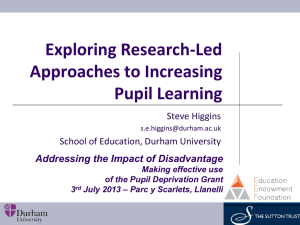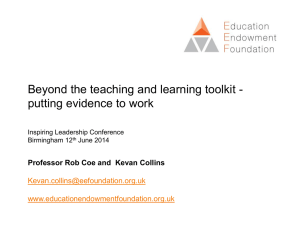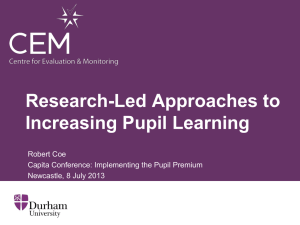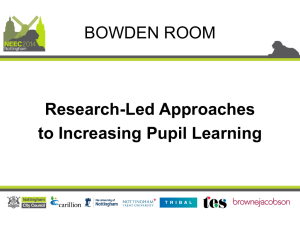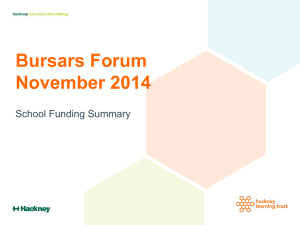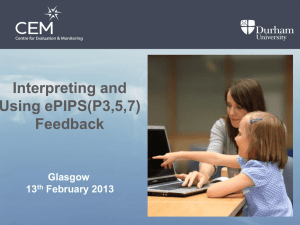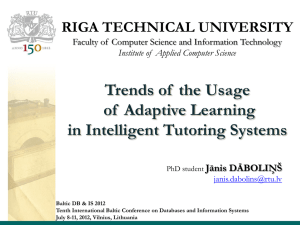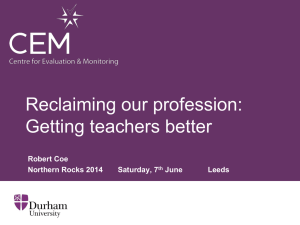pupil_premium_lac_presentation
advertisement
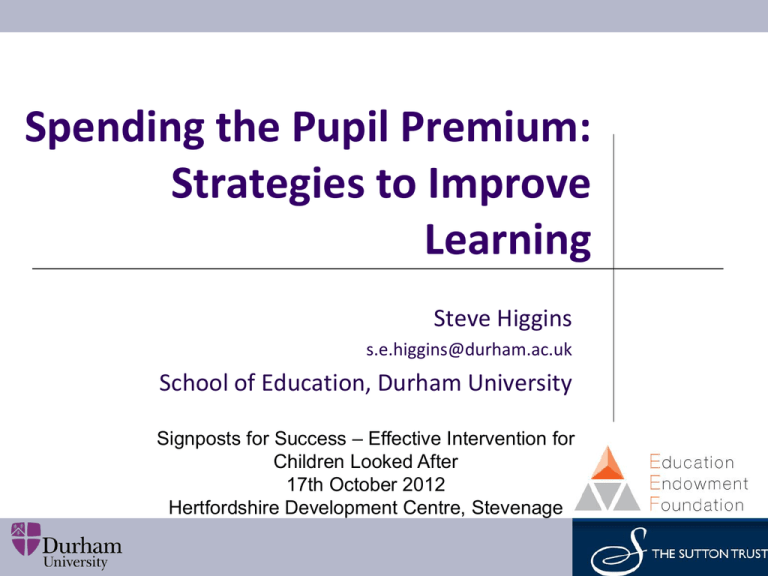
Spending the Pupil Premium: Strategies to Improve Learning Steve Higgins s.e.higgins@durham.ac.uk School of Education, Durham University Signposts for Success – Effective Intervention for Children Looked After 17th October 2012 Hertfordshire Development Centre, Stevenage Sutton Trust Report on Spending the Pupil Premium: Toolkit of Strategies to Improve Learning Why we wrote it Best ‘buys’ Worst ‘buys’ Learning How might we use it? http://educationendowmentfoundation.org.uk/toolkit The pupil premium Aims: to reduce the attainment gap between the highest and lowest achieving pupils nationally to increase social mobility to enable more pupils from disadvantaged backgrounds to get to the top Universities to provide additional resource to schools to do this to support looked after children £600 in 2012-13 for fsm1 pupils; rising to £900 in 2013-14 and £1200 in 2014-15? 1 any child registered for fsm in the last six years and all looked after children Resources and learning Above a minimum threshold – no simple link More money ≠ more learning There is an association but weak and complex Conclusion: spending more won’t guarantee benefit- no simple solution The question How should a school spend any extra ‘discretionary’ budget to achieve maximum benefits in learning? The Bananarama Principle It ain’t what you do it’s the way that you do it… So how do you spend £600/pupil to “get results”? Or, what does the evidence say is a good investment or a poor investment for learning? It ain’t what you spend but the way that you spend it… Resources and learning Smaller classes? Complex evidence- no clear link with class size and achievement Experimental trials suggest Classes need to be less than about 17 And teachers need to change the way they teach But teaching assistants not as effective The maths: £600 x 20 pupils x 3 classes = £27,000 50%+ on fsm = 1 extra teacher per 3 classes Class size reduction from 30 to 23 – not enough One-to-one tuition Highly effective The maths… I hour/ day over at least 6 weeks Support for class teacher to re-integrate 6 weeks x 5 days x 1 hour = 30 hours 4 days teacher time (more effective with an experienced teacher) Approx £800 May work if you use pairs and target pupils only need it once a year – expensive but effective What we tried to do Summarise the evidence from meta-analysis about the impact of different strategies on learning (attainment). Apply quality criteria to evaluations: rigorous designs only Estimate the size of the effect As found in research studies These are averages Standardised Mean Difference = ‘Months of gain’ Estimate the costs of adopting Information not always available Best ‘buys’... Toolkit Toolkit Worst ‘buys’... Toolkit Summaries What is it? How effective is it? How secure is the evidence? What do I need to know? Approaches and effect size estimates 0.8 0.7 0.6 Effect size 0.5 0.4 0.3 0.2 0.1 0 -0.1 Approach Toolkit Overview of value for money Promising 10 May be worth it Effect Size (months gain) Feedback Meta-cognition EY intervention Peer tutoring 1-1 tutoring Homework 0 £0 Summer schools Phonics Parental involvement Learning Individualised Sports learning styles Arts Performance Ability grouping pay Cost per pupil ICT Smaller classes After school Not worth it £1000 Teaching assistants Issues and limitations Based on meta-analysis – averages of averages Conversion to ‘months progress’ is a rough estimate Intervention research is compared with ‘normal’ practice which is varied Not ‘what works’ but what has worked – ‘good bets’ to support professional evaluation and enquiry Key messages Some things that are popular or widely thought to be effective are probably not worth doing Ability grouping (setting); After-school clubs; Teaching assistants; Smaller classes; Performance pay Some things look ‘promising’ Effective feedback; Meta-cognition and self regulation strategies; Peer tutoring; Homework (for secondary pupils) Feedback “… we have each been asked several times by teachers, ‘What makes for good feedback?’—a question to which, at first, we had no good answer. Over the course of two or three years, we have evolved a simple answer—good feedback causes thinking.” (Black & Wiliam, 2003) Meta-cognition and self regulation strategies Teaching approaches which make learners’ thinking about learning more explicit in the classroom. E.g. teaching pupils strategies to plan, to monitor and to evaluate their own learning. It is usually more effective in small groups so learners can support each other and make their thinking explicit through discussion. Self-regulation refers to managing one’s own motivation towards learning AND managing one’s thinking and reasoning (cognitive aspects). Peer tutoring Learners work in pairs or small groups to provide each other with explicit teaching support. The learners take on responsibility for aspects of teaching and for evaluating the success of their peers. Cross-Age Tutoring an older learner usually takes the tutoring role and is paired with a younger tutee or tutees. Peer-Assisted Learning Strategies (PALS) is a structured approach for mathematics and reading requiring set periods of time for implementation of about 25-35 minutes 2 or 3 times a week. Reciprocal Peer Tutoring: learners alternate between the role of tutor and tutee. Effective strategies Effective feedback (needs trust) Build learning relationships Support social interaction and support One-to-one tuition – with an experienced teacher Small group collaborative learning Is that it? Have we solved the problem of how to improve attainment? The challenges (1): implementation These strategies have been shown to be cost-effective in research studies But when we have tried to implement evidence-based strategies we have not seen system-wide improvement (e.g. AfL) We don’t know how to get schools/teachers who are not currently doing them to do so in ways that are True to the key principles Feasible in real classrooms – with all their constraints Scalable and replicable Sustainable The challenges (2) : making it work for you This is what has worked (on average) Where is there leverage for improvement in your work? Will it build capacity? For learners? For teachers? How will this apply to children looked after? Research example: Letterbox club Once‐monthly personalised parcels posted to children in their foster homes Reading materials, story CDs, stationery and mathematics games 7‐ 11 years, May to October Aims to improve attainment levels in reading and number skills Booktrust, Leicester Uni, DfE http://fileserver.booktrust.org.uk/usr/resources/516/queens-letterbox-evaluation-full-report-1-1-.pdf Winter K., Connolly P., Bell, I. and Ferguson, J. (2011) An Evaluation of the Effectiveness of the Letterbox Club in Improving Educational Outcomes among Children Aged 7‐11 Years in Foster Care in Northern Ireland, Belfast: Centre for Effective Education, Queen’s University Belfast. How will the Toolkit develop? Next update planned for January – a more dynamic resource with evidence of effective practice based on rigorous evaluation It will grow as the evidence base does; EEF projects will help fill-in the gaps and expand the scope The EEF will also create practical examples of the interventions backed up by evidence – e.g. training, programmes and approaches that schools can use Links The full report can be found on the EEF’s website: http://educationendowmentfoundation.org.uk/toolkit/ With information about the background to the analysis: http://educationendowmentfoundation.org.uk/uploads/pdf/Technical_Appendi ces_(July_2012).pdf The toolkit is recommended by the Department for Education: http://www.education.gov.uk/schools/pupilsupport/premium/b00200492/ppst rategies Official information about the Pupil Premium and LA allocations is available at: http://www.education.gov.uk/schools/adminandfinance/financialmanagement/ schoolsrevenuefunding/a00200697/pupil-premium-2012-13 Ofsted’s report is available at: http://www.ofsted.gov.uk/resources/pupilpremium High Impact Low cost High cost Low Impact Key points What will you do? How will you connect this to learning? How will you connect this to attainment? BUT what will you stop doing? For every complex problem there is a solution that is simple, neat… and WRONG! H.L. Mencken 1880-1956
